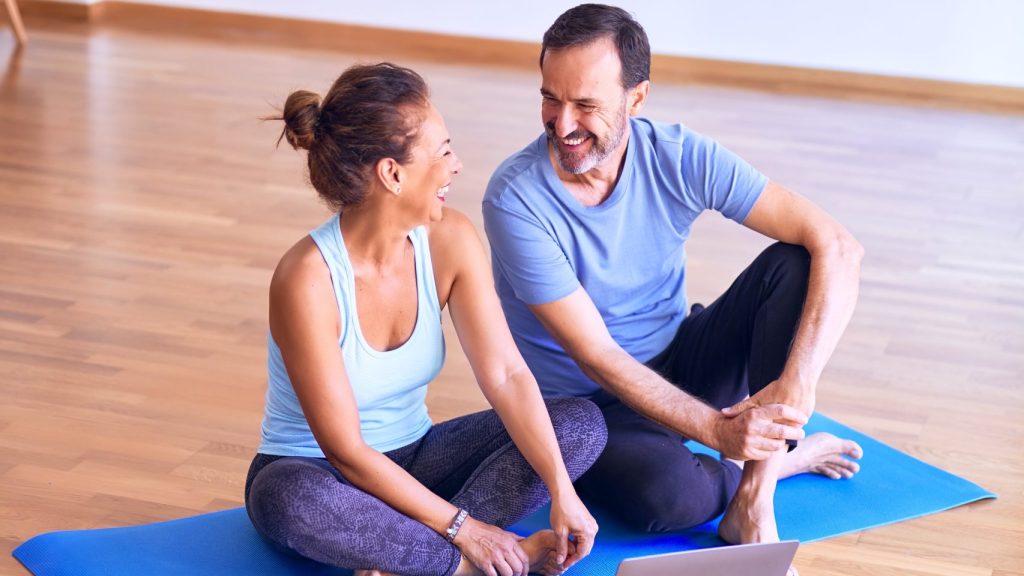Table of Contents
In today’s dynamic world of fitness, harnessing the profound synergy between mind and body isn’t just a luxury—it’s essential. Mind-Body Techniques for Enhanced Muscle Activation not only stands as a testament to this age-old wisdom but has also cemented its importance in contemporary training regimes. As fitness enthusiasts worldwide seek to maximize their potential, these techniques pave the way to optimize every rep, every stretch, and every breath. Let’s dive into this riveting realm, unraveling its relevance and empowering you, dear reader, to integrate these methods seamlessly into your fitness journey.
The Science Behind Mind-Body Connection and Muscle Activation
Every fitness enthusiast has felt it – that moment where your body is weary, but your mind pushes you to complete just one more rep. This deep-rooted connection between the mind and body plays a pivotal role in muscle activation. But what does science say about it?
The mind-body connection refers to the intricate relationship between our thoughts, feelings, and bodily responses. Neurological studies have demonstrated that the brain releases specific neurotransmitters in response to mental stimuli. These neurotransmitters can influence muscle tension, responsiveness, and overall activation .
For instance, when you’re mentally prepared and focused on a particular exercise, your brain better communicates with the targeted muscles, resulting in more effective contractions. In contrast, mental distractions or stress can hinder this communication, leading to subpar performance.
Visualization, a powerful mind-body tool, leverages this connection. By mentally rehearsing a movement, you’re essentially priming your brain and muscles for the actual action. Studies have shown that athletes who engage in mental rehearsals can indeed enhance their physical performance, even without physical practice.
Another aspect to consider is the placebo effect. In fitness settings, simply believing that a particular technique or supplement will enhance muscle activation can lead to actual improvements. This psychological phenomenon underscores the power of belief in influencing our physical state.
💡 Tip: The next time you’re about to embark on a strenuous workout, take a moment to mentally prepare. Visualize the exercises, focus on the targeted muscles, and believe in your ability to perform at your best.
Visualization Techniques for Improved Performance
Visualization, often hailed as a mental rehearsal, has been a cornerstone of athletes’ training regimens for years. Yet, it’s not only elite sportspeople who can benefit from this powerful mind-body technique. Every fitness enthusiast, from a gym newbie to a marathon runner, can employ visualization to enhance their performance and get the most out of their workouts. But how exactly does it work? And how can one incorporate it into their routine? Let’s delve in.
Visualization is all about creating a detailed mental image of a specific event or action. By vividly picturing yourself achieving your fitness goals, whether it’s perfecting a yoga pose, lifting a certain weight, or crossing the finish line, you’re essentially priming your brain and body for success.
Research has shown that when you visualize an action, the brain generates an impulse that tells your muscles to perform the movement. This creates a neural pattern in your brain as if you had physically executed the action. Over time, this mental rehearsal can help improve muscle memory, making the actual physical performance more effortless and efficient.
To integrate visualization into your fitness journey, start by setting aside a few minutes before your workout. Find a quiet space, close your eyes, and vividly imagine the following:
- The Setting: Picture the environment where you’ll be working out, be it a gym, a park, or your living room.
- The Movements: Visualize yourself going through the exercises, focusing on the form, breathing, and muscle engagement.
- The Feel: Imagine the sensations, from the muscle burn to the exhilaration of completing a challenging set.
📌 Key Point: Consistency is crucial. Just as physical training requires repetition, so does mental training. Regularly practicing visualization can lead to more pronounced benefits over time.
But visualization doesn’t end post-workout. As you cool down or stretch, replay the session in your mind. Celebrate the successes and mentally rehearse areas that need improvement. This reflection helps reinforce positive outcomes and prepares you for future sessions.

Meditation and Its Role in Muscle Recovery
Meditation has long been heralded for its mental and emotional benefits, particularly its ability to reduce stress and enhance mindfulness. But for those entrenched in the fitness realm, there’s an often overlooked benefit of meditation: its profound impact on muscle recovery.
The exercise, especially intense or prolonged activity, puts a considerable strain on our muscles. While this is part of the growth process, the recovery phase is where the magic truly happens. This is where muscles repair, grow, and strengthen. The faster and more efficiently this recovery happens, the better prepared one is for their next workout.
So, how does meditation come into play? It’s all about the relaxation response. When you meditate, you activate the body’s relaxation response, reducing the production of stress hormones like cortisol. Elevated cortisol levels have been linked to prolonged muscle recovery and inflammation. By lowering these levels through meditation, one can potentially accelerate muscle recovery.
Moreover, meditation promotes better sleep, a critical component of muscle recovery. With regular meditation, individuals often report improved sleep quality and duration. Given that most muscle repair and growth occur during deep sleep, enhancing sleep quality directly impacts recovery.
📌 Key Point: While meditation might not be the first tool that comes to mind for muscle recovery, its indirect benefits can significantly influence how quickly and efficiently your muscles repair and grow.
Breathwork for Enhanced Stamina and Strength
Breathing is fundamental to life, yet so many of us underestimate its power, especially when it comes to fitness. Breathwork, or the conscious control and manipulation of breathing patterns, offers a bridge between the mind and body that can drastically impact stamina and strength.
When you think about a workout, you might recall instances where you were out of breath after a set of burpees or while sprinting. This isn’t just a sign of fatigue but a reminder of how central breathing is to our physical capabilities. Proper breathwork can make a notable difference in both aerobic (endurance) and anaerobic (short, intense) exercises.
For example, diaphragmatic breathing, where one breathes deeply into the diaphragm rather than shallowly into the chest, allows for better oxygen exchange. This not only improves stamina but also aids in muscle function, ensuring they get the oxygen-rich blood they need during intense workouts.
Breathwork also plays a role in muscle strength. Techniques like the “Valsalva maneuver,” where one holds their breath to stabilize the core during heavy lifting, can enhance performance and safety. This type of breath control aids in maintaining intra-abdominal pressure, offering a stable base from which muscles can exert force.
📌 Key Point: While it may seem counterintuitive, holding your breath during specific exercises (like weight lifting) can be beneficial. However, it’s essential to understand the correct techniques and when to apply them.
Additionally, breathwork exercises outside of your workout routine can have significant benefits. Regular practices can increase lung capacity, improve cardiovascular health, and reduce stress, all of which contribute to enhanced fitness performance.
Call to Action: Start paying attention to your breathing patterns during your next workout. Consider integrating dedicated breathwork sessions into your routine to tap into these benefits.

Incorporating Mind-Body Practices into Your Daily Fitness Routine
Making the connection between the mind and body is not just a philosophical endeavor—it’s a practical one, especially when aiming for a comprehensive and holistic approach to fitness. While we’ve dived into the scientific reasons, visualization, meditation, and breathwork’s individual benefits, the key now is to make these practices a routine.
Starting might seem challenging, but the results are worth the effort. Here’s a guide to seamlessly incorporating mind-body practices into your daily fitness routine:
Set Clear Intentions
Begin each workout session by setting an intention. This can be as simple as deciding on a goal for the day, like improving squat form or achieving a particular mind-set, such as staying present throughout the workout. This mental commitment can drive purpose and focus in each movement.
Incorporate Visualization
Before diving into an exercise, take a moment to visualize the outcome. For instance, if you’re about to lift weights, picture yourself completing the reps effortlessly and with perfect form. This mental rehearsal can prime the muscles and increase the chances of actualizing what you’ve visualized.
Embrace Short Meditation Sessions
You don’t need to meditate for hours. Just a few minutes before or after your workout can do wonders. This can help in centering your mind, preparing it for the workout ahead, or aiding in recovery and relaxation post-exercise.
Prioritize Breathwork
Whether it’s diaphragmatic breathing during aerobic exercises or the Valsalva maneuver in weight lifting, be conscious of your breathing patterns. Incorporating specific breathwork exercises into your warm-ups or cooldowns can also prove beneficial.
Stay Consistent and Patient
As with any new practice, consistency is key. It might take some time before you notice significant changes, but the cumulative benefits of these mind-body techniques will undoubtedly enhance your fitness journey over time.
In Conclusion: The Synergy of Mind and Body in Amplifying Fitness Outcomes
In the evolving world of fitness, it’s becoming clear that the mind-body connection isn’t merely a fancy buzzword—it’s an essential element for those seeking holistic health and peak performance. Embracing the science behind this connection, harnessing the power of visualization, understanding the recovery benefits of meditation, and using breathwork to enhance strength are all paramount to a rounded fitness journey. By taking small yet consistent steps in incorporating these practices daily, fitness enthusiasts can unlock a new dimension to their routines, experiencing not just physical gains, but mental and emotional growth as well. So, as you lace up those training shoes and prep for your next session, remember: your mind is just as powerful a tool as any equipment in the gym.
Citations Section:
- Achtziger, A., Gollwitzer, P. M., & Sheeran, P. (2008). Implementation intentions and shielding goal striving from unwanted thoughts and feelings. Personality and Social Psychology Bulletin, 34(3), 381-393.
- MacIntyre, T. E., Igou, E. R., Campbell, M. J., Moran, A. P., & Matthews, J. (2014). Metacognition and action: a new pathway to understanding social and cognitive aspects of expertise in sport. Frontiers in psychology, 5, 1155.
- Tang, Y. Y., & Posner, M. I. (2014). Training brain networks and states. Trends in cognitive sciences, 18(7), 345-350.
- Zaccaro, A., Piarulli, A., Laurino, M., Garbella, E., Menicucci, D., Neri, B., & Gemignani, A. (2018). How breath-control can change your life: A systematic review on psycho-physiological correlates of slow breathing. Frontiers in Human Neuroscience, 12, 353.